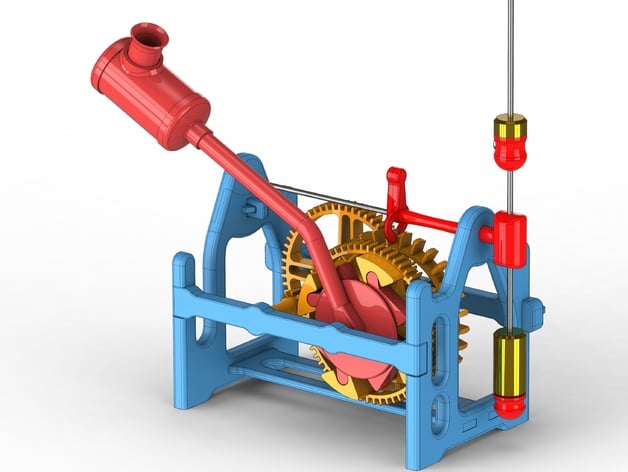
Metronome Engine
thingiverse
Metronome Engine. I built a test rig to verify calculations for a compound pendulum I had done in Excel for a new wooden clock design. The rig design was based on the metronome engine's mechanism, which uses a compound pendulum, making it an ideal choice for 3D printing. The rig is powered by a weight inside a steam engine style boiler attached to a stalk, driving an escape wheel through a gravity ratchet and gears to achieve about 2.5 minutes of running time. The compound pendulum controls the tick-tock rate. Moving the top weight down slows it, while moving it up speeds it up. The top and bottom weights can be swapped for larger or smaller ones to alter the rate further. With all these options, fine-tuning was straightforward to find a combination that could be scaled up for use in a larger wooden clock. This rig could easily be modified to include a scale, making it functional as a metronome. As is, it's a nice gadget to create on your 3D printer. To assemble the Metronome Engine, you will need one of each STL part except for Spacer 3 (2 parts), Pawl (4 parts), Wedge (3 parts), and Escapement (2 parts that must be solvent bonded together). You'll also need extra components: * 6 roller bearings Ø2mm x Ø6mm x 3mm * A piece of Ø1.5mm steel rod for the pendulum * A piece of Ø2mm steel rod for the pendulum pivot * Two pieces of Ø2mm steel rod for the gear shafts * Acetone to solvent bond the frame and other parts together * Ø9.5mm steel balls (catapult ammo) for the weight * Ø12mm Brass rod or washers, 8 grams for the top weight, and 23 grams for the bottom weight * A magnet Ø5 x 5mm long to hold the top pendulum weight in position STL files are grouped into Blue, Red, and Orange. Use the drawing as a guide for where the components fit into the assembly. For more detail, visit http://www.3dprinterclocks.com/page19.html. Watch a video of the working rig at https://youtu.be/jI1B_eK7I_Q. STL files are grouped in 3 ZIP files. Print Settings: * Printer: Zortrax M200 * Rafts: Yes * Supports: Yes * Resolution: 0.14mm * Infill: Medium Notes: Most parts can be positioned to avoid supports, but some will need them. Generally, infill is medium, but small parts would benefit from a denser infill. Post-Printing: Drilling the gears requires drilling the gears and spacers on cross shafts to Ø2.5mm for a loose fit on the shafts. The T-connector and Escapement must be a tight fit on their respective shafts. There's a small magnet fitted to the top pendulum weight support that will grip on the Pendulum shaft until moved by hand. The Escapements might need slight adjustments with a file to work properly.
With this file you will be able to print Metronome Engine with your 3D printer. Click on the button and save the file on your computer to work, edit or customize your design. You can also find more 3D designs for printers on Metronome Engine.
